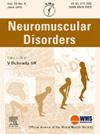276th ENMC workshop: recommendations on optimal diagnostic pathway and management strategy for patients with acute rhabdomyolysis worldwide. 15th-17th March 2024, Hoofddorp, The Netherlands
IF 2.7
4区 医学
Q2 CLINICAL NEUROLOGY
引用次数: 0
Abstract
The 276th ENMC Workshop on rhabdomyolysis brought together 21 experts to address the compelling need for standardized guidelines on the clinical approach of rhabdomyolysis. There was a general agreement that a diagnosis of rhabdomyolysis require that 1) clinical symptoms include severe muscle swelling, weakness and/or myalgia; 2) serum CK-levels exceed 10,000 IU/L in case of exertional, and >5000 IU/L in non-exertional rhabdomyolysis; 3) CK-levels reaching a maximum 1–4 days after the event and normalizing to baseline within 1–2 weeks of rest. In case of an underlying neuromuscular condition, CK-levels should exceed 5–10 times the patient's baseline level. Treatment should be initiated only in case of high risk on acute kidney injury, which can be predicted by the McMahon score. Furthermore, recommendations on performing genetic testing were formulated and the use of the ‘RHABDO’- acronym was generally agreed upon as a tool to aid clinicians in deciding which patients require genetic testing. Moreover, recommendations on follow-up were made, with a particular emphasis on evaluation of physical and psychological sequelae. Patient representatives present during the workshop emphasized the importance of the current recommendations for future clinical guidelines on rhabdomyolysis.
第276届ENMC研讨会:关于全球急性横纹肌溶解患者最佳诊断途径和管理策略的建议。2024年3月15日至17日,荷兰胡夫多普
第276届ENMC横纹肌溶解研讨会汇集了21位专家,讨论了对横纹肌溶解临床方法标准化指南的迫切需求。一般认为诊断横纹肌溶解需要1)临床症状包括严重的肌肉肿胀、无力和/或肌痛;2)劳累性横纹肌溶解时血清ck水平超过10000 IU/L,非劳累性横纹肌溶解时血清ck水平超过5000 IU/L;3) ck水平在事件发生后1-4天达到最大值,休息1-2周后恢复到基线水平。如果有潜在的神经肌肉疾病,ck水平应超过患者基线水平的5-10倍。只有在急性肾损伤风险较高的情况下才应开始治疗,这可以通过McMahon评分来预测。此外,制定了关于进行基因检测的建议,并普遍同意使用“RHABDO”-首字母缩略词作为帮助临床医生决定哪些患者需要基因检测的工具。此外,还就后续行动提出了建议,特别强调对身体和心理后遗症的评价。在研讨会上,患者代表强调了横纹肌溶解临床指南的重要性。
本文章由计算机程序翻译,如有差异,请以英文原文为准。
求助全文
约1分钟内获得全文
求助全文
来源期刊

Neuromuscular Disorders
医学-临床神经学
CiteScore
4.60
自引率
3.60%
发文量
543
审稿时长
53 days
期刊介绍:
This international, multidisciplinary journal covers all aspects of neuromuscular disorders in childhood and adult life (including the muscular dystrophies, spinal muscular atrophies, hereditary neuropathies, congenital myopathies, myasthenias, myotonic syndromes, metabolic myopathies and inflammatory myopathies).
The Editors welcome original articles from all areas of the field:
• Clinical aspects, such as new clinical entities, case studies of interest, treatment, management and rehabilitation (including biomechanics, orthotic design and surgery).
• Basic scientific studies of relevance to the clinical syndromes, including advances in the fields of molecular biology and genetics.
• Studies of animal models relevant to the human diseases.
The journal is aimed at a wide range of clinicians, pathologists, associated paramedical professionals and clinical and basic scientists with an interest in the study of neuromuscular disorders.
 求助内容:
求助内容: 应助结果提醒方式:
应助结果提醒方式:


